by Michael R. Allen

The impending closure of Catholic girls’ school St. Elizabeth Academy revisits territory hotly debated in Tower Grove East two years ago, when the Academy threatened to demolish parts of its historic campus to make itself more marketable. The Board of Directors of St. Elizabeth Academy and its tireless, persistent President, Sister Susan Borgel, were facing the reality that the very existence of the 131-year-old institution was threatened. A possible counteract was to demolish all of the buildings on the campus save a 1957 wing on Arsenal Street, and build contemporary facilities that other Catholic schools like Nerinx Hall and Rosati-Kain were able to provide. After careful consideration, the Tower Grove East Neighborhood Association formally opposed the demolition, but also pledged to assist the Academy’s efforts to sustain itself should preservation of its historic buildings be part of the plan. The crux of historic preservation again surfaced: do we first preserve buildings or communities of people that support buildings? Should cultural resource laws protecting buildings be bent when historic institutions’ futures are on the line?
What Gets Preserved?
Therein lay a conflict more philosophical than personal. To the neighborhood, sustainability meant retention of a sense of place that both long-time and new residents cherished. Part of the sense of place was the close at Crittenden Street, wonderfully unusual for south city, framing St. Elizabeth Academy former main entrance. To St. Elizabeth Academy, sustainability meant the survival of the institutional life of the city’s second-oldest Roman Catholic High School, which offered education to families who could not afford the tuition or commute time to other Catholic girls’’ schools. Once the school student body numbered more than 500, but now it stands at 133. Teaching sisters used to live on-site in the convent, but today that model of a Catholic school is not viable. The glorious buildings were made possible by the former scale, and became a liability with the latter. These two visions of sustainability ought to have been reconciled easily, but the Board of Directors of St. Elizabeth Academy seemed to view the Tower Grove East Neighborhood Association as a hostile force.
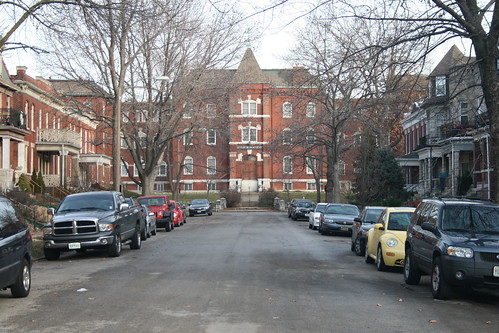
Perhaps the rift widened when neighborhood residents expressed views that suggested preference for closing the Academy and converting its valuable historic buildings into housing or some other use that the Sisters of the Most Precious Blood, operators of the academy, did not sanction. Thou shalt not covet thy neighbor’s house is a deep imperative that could prevent much trauma to city neighborhoods if followed. If residents were guilty of looking at the buildings’ futures without considering the value of the institution, the Academy had its own baggage. According to a source, the board once discussed buying out the block of houses east of Louisiana Avenue for expansion of its grounds.
Rather than reach a working position, the neighborhood and the Academy seemed to fade from their positions. There was some suspicion that the Academy’s fate was not bright when there was no follow-up to the early controversial plan to raise funds for campus improvement. All the while, St. Elizabeth Academy continued to maintain a social economy that included students and parents from Tower Grove East and other neighborhoods. That these families could send their daughters to a historic school in a safe, attractive neighborhood adjacent to Tower Grove Park rather than out to St. Louis County made an untold difference that will now be harshly felt in absence.
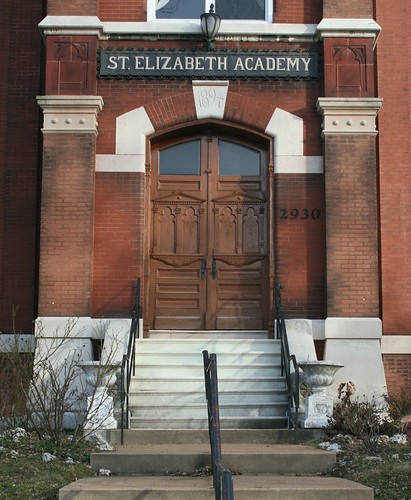
Whether Tower Grove East and St. Elizabeth Academy could have formed a partnership around the future of the school is unknown now. The unfortunate stalemate should caution neighborhoods and institutions in future negotiations, because both could end up losing. Of course, central to this caution is recognition that the “campus†myth of expensive new facilities in place of beloved and adaptable older educational buildings is ill-advised and cost-prohibitive in the current era. “Most progress toward local economies will probably arise not so much from grand visions as from slow modifications,” wrote Bill McKibben in Deep Economy. Slow modifications — of buildings, of relationships between schools and neighborhoods — are how great cities sustain both their built environments and their social capital.
Preservation of the St. Elizabeth Academy Buildings
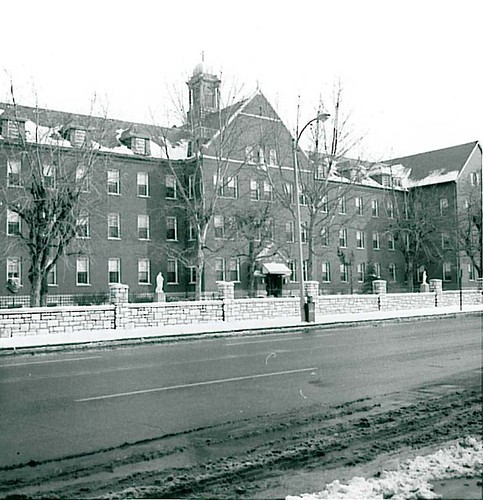
Long memories support the recent fears of loss the St. Elizabeth Academy buildings. In the 1980s, the Tower Grove East neighborhood lost the Little Sisters of the Poor Home for the Aged at the southeast corner of Grand and Cherokee streets. Schnuck’s wrecked the historic complex for a new grocery store, which is partially surrounded by the historic stone walls built by the Little Sisters of the poor. Other institutional buildings in the neighborhood that have been lost include the Liederkranz Club on Grand Avenue at the head of Magnolia Avenue (also now the site of a grocery store) and the Tower Grove Turnverein at the southeast corner of Grand and Juniata streets (now a parking lot). In none of these instances did the neighborhood’s sense of place benefit from demolitions.
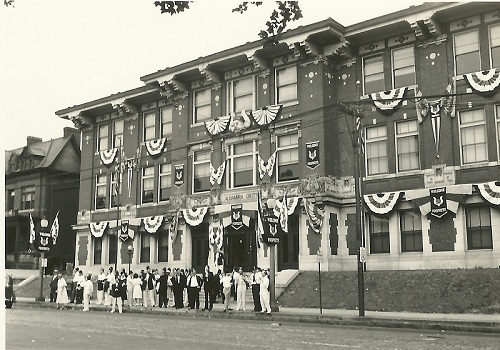
Of course, preservation of St. Elizabeth Academy’s buildings could well be more likely now that the school is closing. That possibility is not highly consoling when one considers the potential difference between dozens of families sending their daughters a few blocks over to school versus driving 20 miles or, worse, even moving 20 miles to avoid long drives to school. Should St. Elizabeth become condominiums, or apartments, the buildings would still stand as testament to the school’s history. Yet the neighborhood will definitely stand robbed of an amenity that aids in the preservation of historic housing stock. Families are not likely to want to live in neighborhoods without schools, and neighborhoods whose cultures are based on driving are not going to be as urbane as those whose populations walk to school, work and shopping. New schools opening in the neighborhood offer some encouragement; perhaps one will look at St. Elizabeth’s buildings and maintain the use.
The St. Elizabeth Academy has been listed in the National Register of Historic Places since 1983 as part of the Crittenden Avenue Historic District. That district has a T-shaped footprint including the two blocks east of the Academy and the Academy itself, and its creation extended modest protection over the unique setting on Crittenden that residents vociferously and rightfully defend. The nomination of the district states the areas of significance as Architecture, Community Planning and Development, Education and Engineering (for the lamella-roofed gymnasium at St. Elizabeth), making it a superbly integrated document.
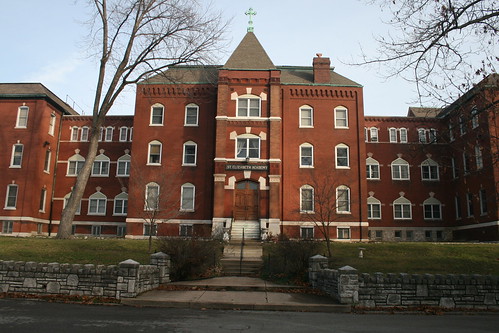
Central to what the historic district protects is the Academy itself. The Sisters of the Most Precious Blood first opened St. Elizabeth Academy in 1882, but the oldest building at the current campus dates to 1894. That Late Victorian building, designed by ecclesiastical architect (and pater familias of generations of Stauders who followed) Joseph Stauder, presents an eclectic, symmetrical mass crowned by a central entrance tower with high pyramidal roof. Limestone and decorative brick, as well as the tall wooden front doors, draw the impressive mass down to the human scale. A north wing built in 1914 from plans by Fransciscan Brother Leonard Darscheid and a south wing of 1922 designed by the firm of Ludwig & Dreisoener (later architects of the lamented, demolished St. Aloysius Gonzaga Church near The Hill) expanded and complemented that original plan.
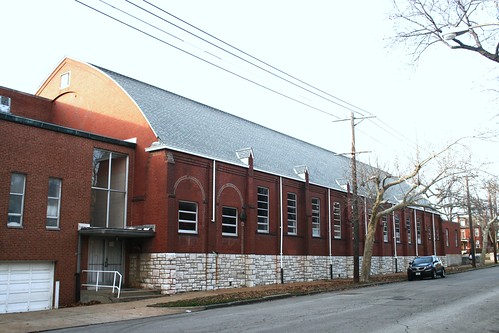
Two later additions added distinct modern elements to the campus worthy of preservation. The gymnasium on Louisiana Avenue, pronounced through a distinct lancet roof form, buttresses forming charming gablets and brick patterning that is expertly rendered, dates to 1927. Designed by architect Henry Dreisoener, the gym’s exterior conceals its highly significant lamella roof — one of the earliest to be found in the Midwest. The lamella roof famously was used in the Arena on Oakland Avenue, constructed in 1929 with engineering by Gustel Kiewitt. Patented in Germany just two years earlier, the lamella roof is based on interlocking transverse arches that strengthen the bow-shaped roof form so that no vertical supports or heavy trusses are needed. German-born engineer and architect Kiewitt arrived in St. Louis to oversee licensed application of the roof system, and likely would have been involved in this project.
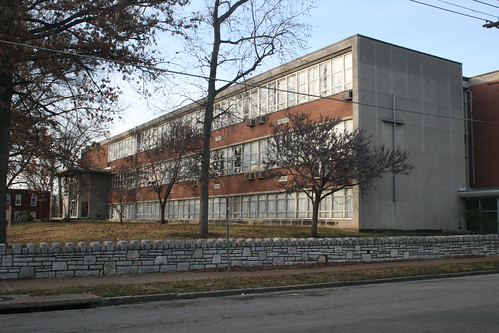
The Sisters of the Most Precious Blood greatly expanded the school in 1957 by demolishing their original home and constructing a three-story addition designed by the firm of Stauder & Stauder. The flat-roofed building emphatically situates itself in the International Style, with its long bands of metal windows, lack of ornamentation and severe geometry. Yet like the best of our local modernist buildings it makes use of local brick and limestone products to render the universalist form is highly regionalist materiality. The setback on Arsenal Street makes it visually unobtrusive, and the retention of the rugged limestone perimeter wall also ties the mass into the red-brick urban setting. Although non-contributing to the historic district, this building is a unique example of a modern work by Stauder & Stauder built as part of expansion of a complex originally designed by Joseph Stauder. The family’s commitment to quality design for Roman Catholic churches and schools evolved with the architectural trends of the modern age, and here that is shown clearly. The building probably could be added as a contributing resource; if not, however, its design and sensitivity to the campus warrants consideration in whatever happens next.
What Happens Next
The Sisters of the Most Precious Blood are greatly familiar to adaptive reuse, as their impressive redevelopment of their Motherhouse in O’Fallon, Missouri shows. (Paul J. McKee, Jr.’s McEagle Development was the lead developer on that project.) With the St. Elizabeth complex already eligible for historic tax credits and protected under city preservation law, and strong neighborhood sentiment for historic preservation, the future of the campus buildings does not seem terribly uncertain. What remains less certain is what happens to the social history of Tower Grove East. Buildings that have been maintained for original use for 119 years all of the sudden will receive major renovation and change. Slow modification will be accelerated, and the setting will never be the same. Today the sun imbued the academy’s brick walls with a brilliant hue, but at the same time there was a mournful quiet around St. Elizabeth Academy. The institution will be missed.

8 replies on “Slow Modifications, Historic Preservation and the Closure of St. Elizabeth Academy”
Well, as a former/recovering Catholic, and current atheist, I’ve noticed that the enrollment in many Catholic schools has dropped over the last few decades. I attended my HS reunion (thirtieth) this past summer, and was struck by the small number of students–declining year by year–who have attended that school. Our graduating class had at least double the number of the most recent class. My guess is that most of the institutions which are now well attended by children possess a student body who aren’t particularly Catholic, and neither are their parents, but the education they receive is still quite good. The education is the most important component, and the religious instruction is largely a secondary consideration. (Though not at my alma mater; an Archdiocesan school, its standards were not nearly as structured and strict as the other Catholic hs in the area). Sadly, St. E was probably doomed, and the rejection of the proposed modifications was hardly the last nail in the coffin for this school. To do everything they proposed would have required at least 20 millionUSD.
Still, I am concerned with the continued loss of business and institutional residents in the City, almost as much as I seethe at the growing ghettoization of that which remains. The BJC and SLU complexes being the most wretchedly and egregiously single-minded in their insularity and insecurity of expression.
Oh, well. Should have gone to university when I was young, and high-tailed it out of this failing burg. And by burg, I mean the entire region. A more incompetent group of business (the bidnessmen ain’t first by mistake) and government leaders one couldn’t find if a contest were held.
Michael, I don’t think you meant to imply what I believe you are implying in the following sentences from your post, but I can assure you that it’s not accurate:
<>
Our neighbors Brad and Maureen DePriest worked really hard on a capital campaign drive for the school once the prospect of demolition was taken off the table. They pledged an *extremely* generous amount, as did some of our neighbors–possibly more would have, too, had the school not made the announcement that they were closing mere weeks after our neighbors spearheaded the campaign. We really weren’t just sitting on our butts doing nothing, and we were all acutely aware of everything we stood lose as residents of this uniquely beautiful historic district (even the childless atheists among us).
I have no idea how the sentences I cited (by copying and pasting) got so colossally screwed up, but I don’t know how to fix it. It was the part about the “unfortunate stalemate,” in any case.
It’s the first two sentences under the photo of the historic main entrance that I meant to quote, beginning with the word “Whether.”
Rather sad that this effort was not only not publicized, but came to naught. It’s also nice to see that my wife and I aren’t the only childless, atheist-citizens who are cognizant of the importance of educating younger citizens.
Totally OT: Rene, I really miss your show on KDHX. One of the best, and frankly, most adult shows on the station. A nice counterpoint to all of the juvenile and lazy jam band shows.
The neighborhood effort was actually pretty well-publicized–letters soliciting donations on behalf of the school went out to everyone in our historic district as well as other concerned parties–but the decision had been made before the organizers even spearheaded it. More behind-closed-doors stuff.
And thank you for the kind words about my show. I miss doing it sometimes, but a serious illness got in the way, and then I felt bad asking for my slot back, when I knew there were so many other people who were so anxious to have the opportunity.
Here’s to what was hopefully a successful and speedy recovery: Cheers!
My wife kept the champagne cork from the bottle she opened to celebrate my “clean” status. She’s a treasure.
Gustel R. Kiewitt did design the roof of the St. Elizabeth Gymnasium. I have copies of the original sketches for the building. – His granddaughter, Melanie Mollman Hancock